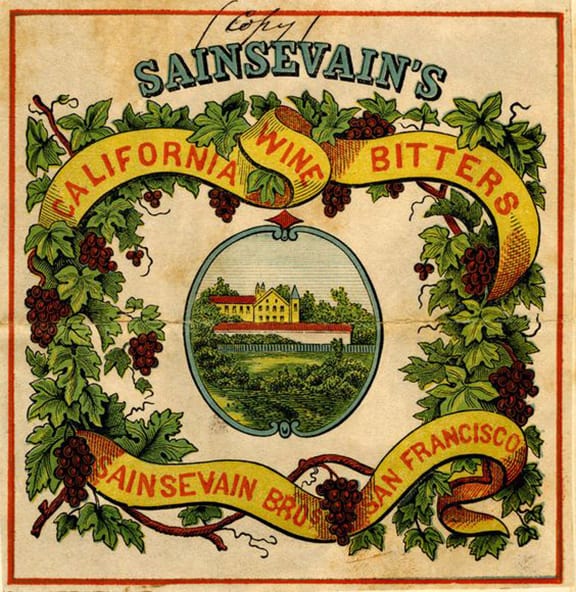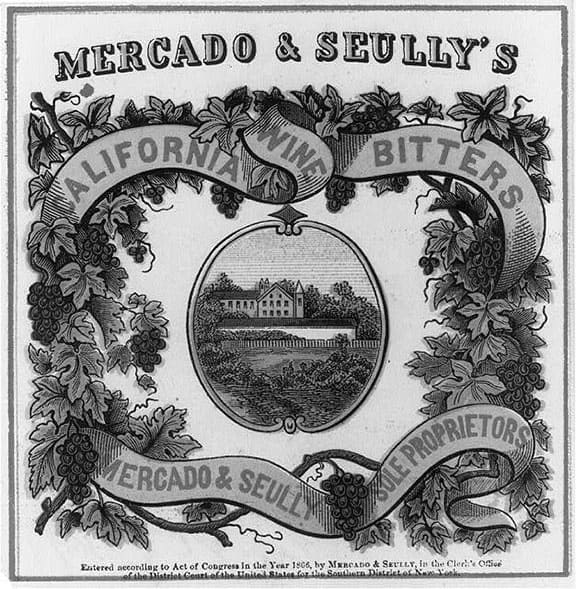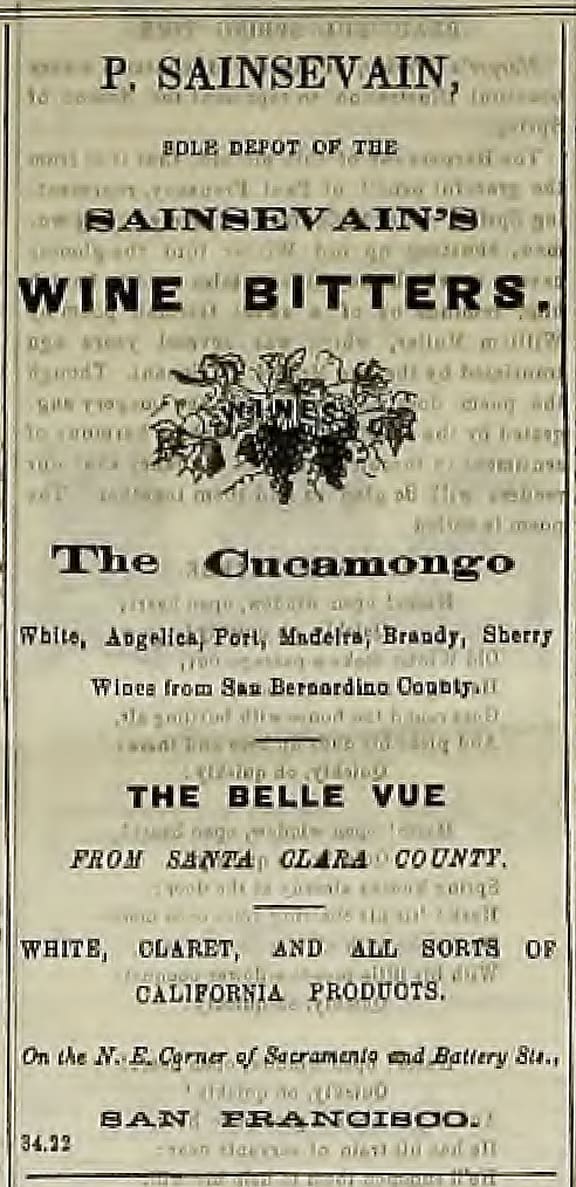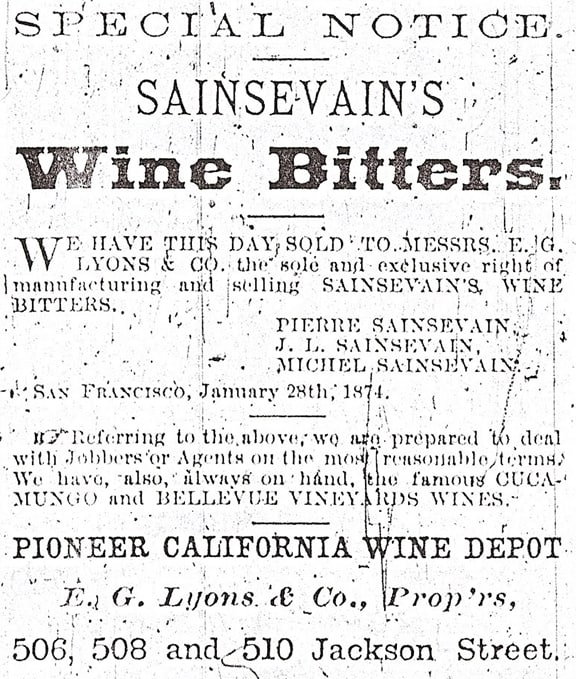
El Aliso, the immense sycamore tree, is visible in the distance in this 1857 photo of the Los Angeles Plaza. Courtesy of the Photo Collection, Los Angeles Public Library.
El Aliso, Jean Louis and Pierre Sainsevain and their California Wine Bitters
24 December 2013 (R•101217)
![]() A little over a year ago, I did a post titled 1865 San Francisco Directory – All Quiet before the Quake. Within the directory, I came across a listing and advertisement for Sainsevain’s California Wine Bitters. I hadn’t thought about this listing until I saw a bitters square on ebay this week also called California Wine Bitters. My excitement was high until I realized it was embossed on one panel, “Wm. Ritmeier’s”. A great bottle nonetheless, but not Sainsevain’s Wine Bitters.
A little over a year ago, I did a post titled 1865 San Francisco Directory – All Quiet before the Quake. Within the directory, I came across a listing and advertisement for Sainsevain’s California Wine Bitters. I hadn’t thought about this listing until I saw a bitters square on ebay this week also called California Wine Bitters. My excitement was high until I realized it was embossed on one panel, “Wm. Ritmeier’s”. A great bottle nonetheless, but not Sainsevain’s Wine Bitters.
Looking in Bitters Bottles by Carlyn Ring and W.C. Ham I see a listing:
S 8 L … Sainsevain’s California Wine Bitters
Manufactured and sold by Mercado & Seully, San Francisco, California
There is no mention of the Sainsevain brothers in the listing which may want to be updated. I am also not aware of any existing bottles with the Sainsevain Wine Bitters label.
Early California Winemaking
Wine making in Los Angeles was raised from a domestic craft to a commercial enterprise by a Frenchman with a name too good to be true, Jean Louis Vignes – because of his name, a French compatriot has written of him, “he seemed predestined to become the Noah of California.” Given his destiny, Vignes was not only well named but well born, for his native place was Cadillac, a winemaking community in the Premieres Côtes de Bordeaux, where his father was a cooper. Jean Louis learned the cooper’s trade, married, and lived quietly until 1826, when, at the age of forty-seven, and for reasons still quite obscure, he left home, wife, family, and trade to go to Hawaii. He could not get satisfactory work in the islands, however, and he had to live from hand to mouth for a time. At last, in 1831, he left for Monterey. The precise date of his arrival in Los Angeles is not known, but he was established in that town by 1833, perhaps drawn there by the reputation of its vineyards and the presence of a Frenchman or two.
and was marked by a great sycamore tree of venerable age called El Aliso
He was somehow able to buy a hundred acres of land. The property lay on the east side of the pueblo, along the river, and was marked by a great sycamore tree of venerable age called El Aliso, to give it the capital letters that all observers agreed that it deserved. Vignes himself came to be called Don Luis del Aliso in honor of his splendid tree. Here Vignes laid out a vineyard that ultimately occupied thirty-five acres and began the manufacture of wine and brandy.
It did not take him long to recognize the inadequacy of the Mission grape, for in 1833 Vignes imported European varieties from France, sent to him by way of Boston and then around the Horn. Vignes thus lays claim to be the first to take the crucial step of obtaining better varieties. We do not know what varieties he imported, however, nor what success he may have had with them, nor whether they entered importantly into the wine he made. The high reputation that his wines established in competition with others from Los Angeles suggests that perhaps they did, but it is also clear that the Mission continued as the overwhelmingly dominant variety in Los Angeles vineyards. If Vignes did actually show a better way, no one yet troubled to follow him. For many years in California it was the custom to call all grapes other than the Mission, “foreign.” The Mission is an unquestioned vinifera, and so just as “foreign” as any other European grape: but the distinction made by the locals is an interesting reflection of their experience.
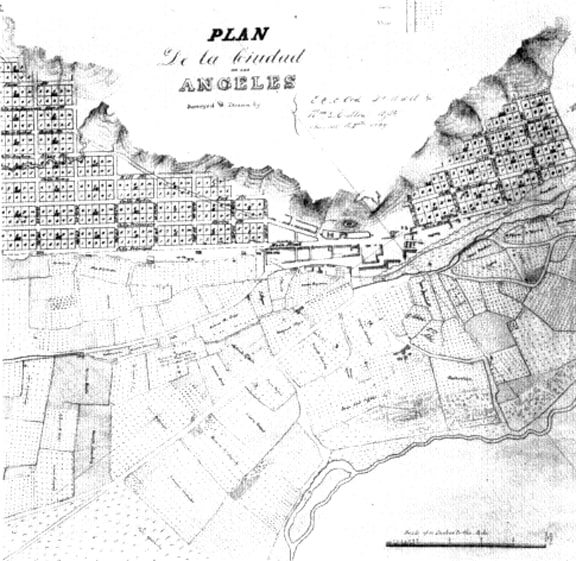
Edward Ord’s map of Los Angeles, 1849, from the copy in the Huntington Library. This is the earliest map of the town after the American annexation. The fields between the town and the river shown closely dotted are planted in vines. Just above and to the right of the island in the river are the vineyards of Jean Louis Vignes. – A History of Wine in America
Pierre Sainsevain
Sainsevain loaded a ship at San Pedro with white wine and brandy and took it to Santa Barbara, Monterey, and San Francisco;
By making acceptable wine in considerable quantity, Vignes was able to take another step forward in 1840, when, through the agency of his nephew. Pierre Sainsevain, newly arrived from France, he made the first recorded shipment of Los Angeles wines. Sainsevain loaded a ship at San Pedro with white wine and brandy and took it to Santa Barbara, Monterey, and San Francisco; at each of these places he was able to get good prices for his cargo. This venture does not seem to have been regularly followed up, but it at least showed the way to an important-later trade.
when he sold his property to his Sainsevain nephews for $42,000, one of the greatest commercial transactions that Los Angeles had ever seen.
Vignes, who was born in 1779, continued to cultivate his vineyard and make wine until 1855, when he sold his property to his Sainsevain nephews for $42,000, one of the greatest commercial transactions that Los Angeles had ever seen. Seven years later, Vignes died. The huge sycamore, El Aliso, that stood at the gate of his property, lasted some years longer, but was cut down before the end of the century; the remarkable grape arbor that ran from Vignes’s house down to the river, perhaps ten feet wide and a quarter of a mile long, has long since been displaced by industrial building. It was, while it stood, one of the public places of Los Angeles, where receptions could be held and parties given under the grateful shade. Vignes himself is still remembered for his effective pioneering, a fact that would have pleased his friend Davis, who wrote in affectionate memory of Vignes.
The Sainsevain Brothers
The wine trade of Los Angeles moved into its next phase in the middle of the 1850s, when two commercial wine houses, like those developed in Cincinnati at about the same time, were set up to consolidate the production, storage, and distribution of the region’s wines. Second in order of founding, but older by virtue of continuing an already operating winery, was the firm of Sainsevain Brothers, Jean Louis and Pierre, the nephews of Jean Louis Vignes. When they bought out their uncle in 1855, they immediately proceeded to expand the scale of operations at the old El Aliso vineyard. They bought wine from other growers, as well as making it from their own grapes and those purchased from local vineyards. In 1857 they opened a store in San Francisco; by 1858 they led the state with a production of 125,000 gallons of wine and brandy.

Sainsevain Brothers listing Sainsevain’s California Wine Bitters – 1862 San Francisco City Directory
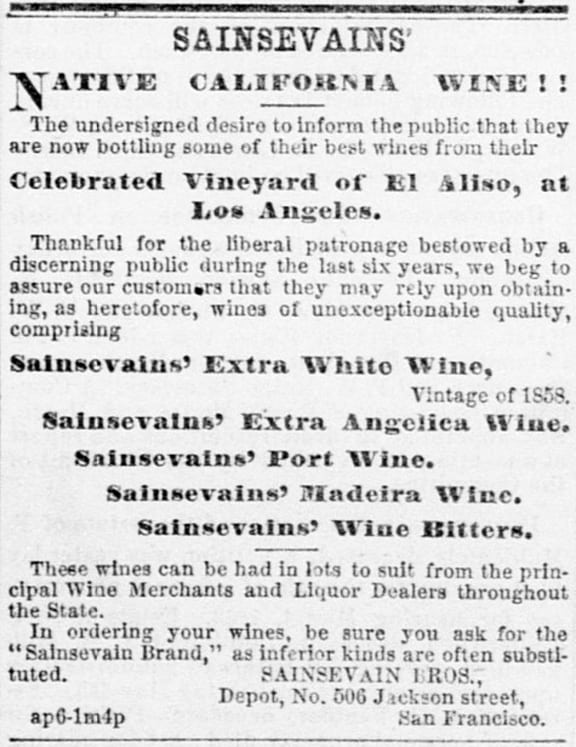
Sainsevain Bros. advertising Native California Wine and Sainsevain’s Wine Bitters – Sacramento Daily Union, 23 April 1863
The fata morgana of the Sainsevain brothers was the wish to make champagne. Pierre, the younger, returned to France in 1856 to study the manufacture, and brought a French champagne maker back with him. In the season of 1857-58 sparkling wine was produced at the San Francisco cellars of the Sainsevain brothers. They called it Sparkling California Champagne, and it was greeted with much interest, shipments being made to New York and Philadelphia to give it the widest publicity. It was not, however, a success. The Mission grape was a poor basis for sparkling wine, which calls for a far more acid juice than the Mission can provide; besides, the Sainsevain methods were not good enough to prevent large losses from breaking bottles and from other causes. The brothers were soon in financial difficulties as a result of their investment in sparkling wine—they are reputed to have lost $50,000 in the venture. Their partnership was dissolved some time early in the 1860s, and only Jean remained at the El Aliso property in 1865 when it was sold. Both Sainsevains, at different times and at different places, kept their hands in the California wine trade thereafter, but the firm was no longer a factor in Los Angeles. – A History of Wine in America
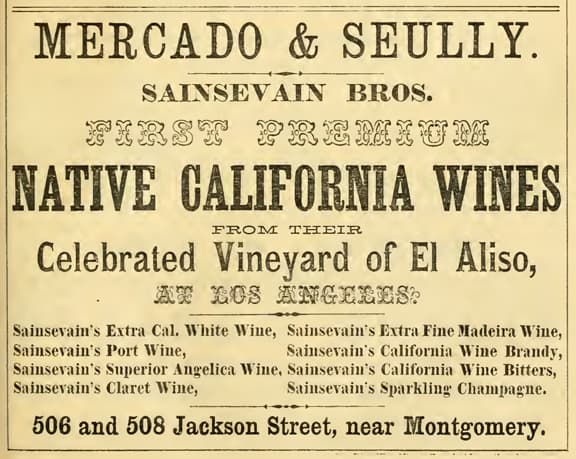
Very similar Sainsevain Brothers listing Sainsevain’s California Wine Bitters. Note addition of Mercado & Seully – 1864 San Francisco City Directory
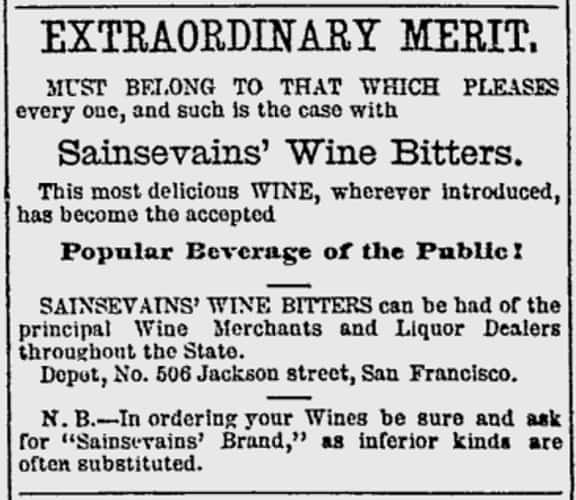
Sainsevain Bros. advertising Native California Wine and Sainsevain’s Wine Bitters – Golden Era, 1865
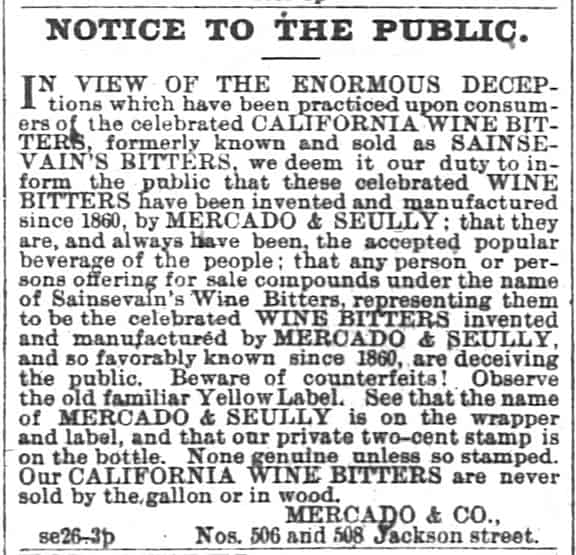
Mercado & Co., Notice to the Public regarding other similar products to Sainsevain’s Wine Bitters being sold. – San Francisco Chronicle, 6 October 1868
Pierre Sainsevain
Pierre “Don Pedro” Sainsevain (November 20, 1818 – October 4, 1904) was a French settler in California during the Mexican era. Sainsevain was the recipient of a Mexican land grant, and built a lumber mill and a flour mill. He was a member of the first California Constitutional Convention; and became a winemaker and the first producer of sparkling wine in California.
and became a winemaker and the first producer of sparkling wine in California.
Sainsevain, a carpenter, came from Bordeaux, France to Santa Barbara, California on the ship Ayacucho on July 4, 1839. He had been sent by his family to find his uncle Jean-Louis Vignes in Los Angeles. He settled on Vignes’ property, El Aliso, and assisted with growing grapes and oranges, and with winemaking. In 1840, he loaded a shipment of wine and brandy on a ship to sell along the California coast. On this trip, he made his first visit to Monterey and Branciforte. In 1841 he worked at Vignes’ sawmill near San Bernardino.
In 1843, Sainsevain was granted Rancho Cañada del Rincon en el Rio San Lorenzo near Santa Cruz, California by Governor Manuel Micheltorena, and in the Fall of 1843 he built one of the first sawmills in the valley of the San Lorenzo River, in association with Charles Roussillon (also known as “Rochon”), another Frenchman. In 1844, he was granted permission to start a flour mill with a daily capacity of 75 fanegas on the Guadalupe River in San Jose. In 1845, Sainsevain married Paula Suñol (1827–1883), whose father Antonio Maria Suñol owned Rancho Los Coches. In 1846, Sainsevain and Charles Roussillon built a schooner (the Antonita) on the beach at Santa Cruz. She was launched on June 25, and sailed to the Sandwich Islands (Hawaii) to have a copper bottom installed. In 1847, Roussillon was the defendant in the first jury trial (Isaac Graham vs. Charles Roussillon) in California.
In 1848, Sainsevain and Roussillon went to the gold mines near Coloma. Sainsevain, Roussillon, Antonio Sunol, and Amador, with help from twenty-five Indians, mined gold at Don Pedro’s Bar on the Tuolumne River. Sainsevain and Roussillon soon had enough of mining and returned to Stockton in 1849 to open a store supplying the California Gold Rush miners. They owned a hotel in San Jose that became California’s first State House. Sainsevain was a delegate to the 1849 California Constitutional Convention in Monterey.
In 1859, Sainsevain sold Rancho Cañada del Rincon en el Rio San Lorenzo, and with his brother, Jean Louis, bought the El Aliso vineyards in Los Angeles from their uncle, Jean-Louis Vignes (also known as “Don Luis Del Aliso”). The firm of Sainsevain Brothers, immediately proceeded to expand the scale of operations at the old El Aliso vineyard. In 1857 they opened a store in San Francisco; and by 1858 they led the state with a production of 125,000 gallons of wine and brandy. In 1857, the San Francisco cellars of the Sainsevain Brothers produced champagne. However, it was not a success, and as a result of their investment in sparkling wine, Sainsevain Brothers was soon in financial difficulties. The partnership was dissolved in the 1860s, and only Jean Louis Sainsevain remained at the El Aliso property when it was sold in 1865.
In 1865 the Sainsevain brothers bought part of Rain’s Rancho Cucamonga and set out a large vineyard.
In 1865 the Sainsevain brothers bought part of Rain’s Rancho Cucamonga and set out a large vineyard. In 1868 his Claret won best wine at the county fair. In 1870, the Sainsevain brothers moved to Cucamonga, and ran the vineyard and winery with Joseph S. Garcia. In 1874, the Sainsevains purchased land in Hawker Canyon four miles east of Etiwanda and built a large stone house and a reservoir.
In 1875, Pierre Sainsevain went to Central America, returning in 1880 to his Sainsevain Villa in San Jose. After his wife’s death in 1883, he returned to France, where he spent the rest of his days. – Wikipedia
Jean Louis Sainsevain
Jean Louis Sainsevain was born at Begney, Department of the Gironde, France, in the year 1816. He came to Los Angeles in 1855, where his uncle, Jean Louis Vignes, the earliest of the French pioneers, and his brother, Pedro Sainsevain, had been living many years. After living here some time, the two brothers bought out the extensive property of their uncle, and carried on the wine business on a large scale till 1867 or 1868.
The brothers Sainsevain were the first manufacturers of champagne in California. They were involved in litigation at one time with the Internal Revenue Department, and also with M. Racoulliat, husband of one of the heirs of their uncle, Don Louis Vignes. Obtaining a franchise to supply the city of Los Angeles with water for domestic use, Don Louis Sainsevain and D. Marchessault, at one time mayor of the city, laid wooden pipes for that purpose, iron pipes being thought at that period too expensive. In 1868 they sold out to the City Water Company, which secured a lease from the city for thirty years, Mr. Sainsevain remaining one of the members of the new company, whose lease expires in 1898.
The immense old “Aliso” (sycamore) tree, around which Don Louis Vignes built his adobe wine cellars, is now surrounded by the modern brick-built plant of the Philadelphia Brewery
The vineyard was sold to Alexander Wiel and others, and was eventually divided up into lots and sold, and it is now occupied by homes and business houses. The immense old “Aliso” (sycamore) tree, around which Don Louis Vignes built his adobe wine cellars, is now surrounded by the modern brick-built plant of the Philadelphia Brewery, and a street railroad runs along where the dwelling of both Vignes and Sainsevain once stood. In after years Sainsevain planted a vineyard at Cucamonga, where he lived some time. Latterly, however, and until his death, which happened in the early part of this year (February 16, 1889), he resided in Los Angeles, where he was well and favorably known as goodhearted, genial “Don Louis” Sainsevain. The street in this city bearing his name was so called in his honor. He had two sons, Michel and Paul. The former died in this city before his father, leaving a widow and several children. Paul and family live in San Diego. Vital Fernando and Jean M. Vignes, for many years residents of Los Angeles, are cousins of the Sainsevains. Pedro Sainsevain, now an old man, who came here when a boy, still lives in San Jose. – An Illustrated History of Los Angeles County, California and Chicago, The Lewis Publishing Company, 1889 Page 814
More: What’s the story behind this ad?
More: Origin of the E.G. LYONS & CO MANUFACTURERS SAN Fco bottle

